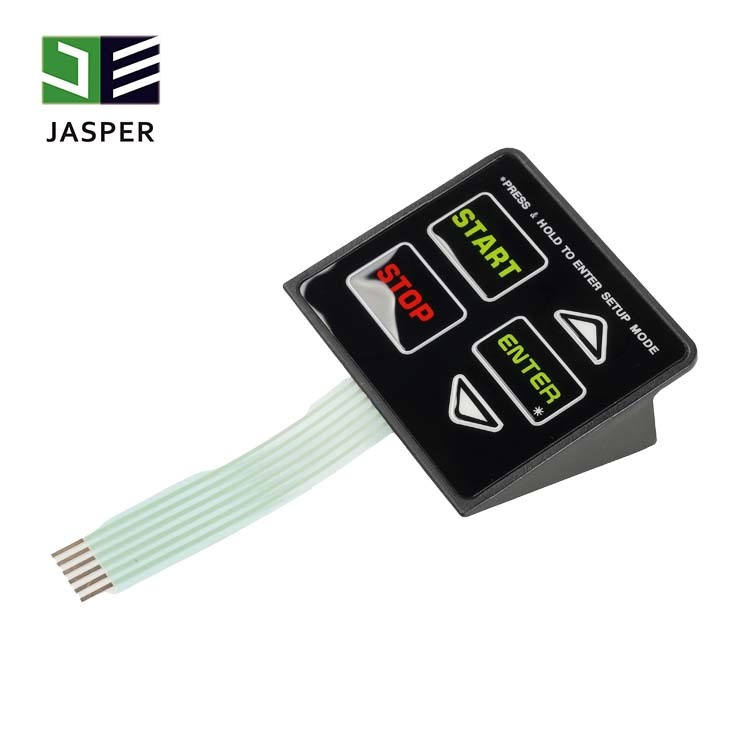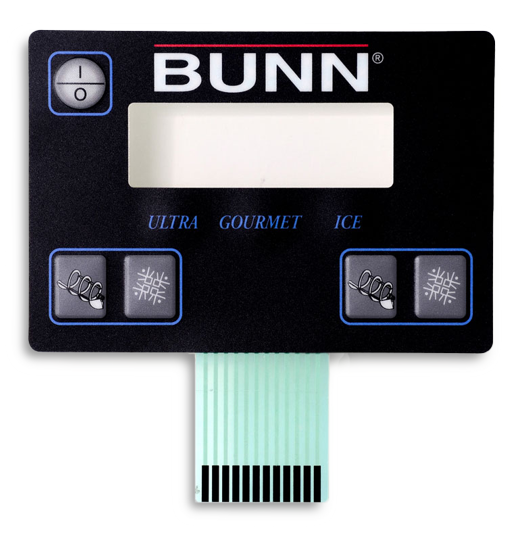Membrane Switch Manufacturer Specializing in OEM Product Integration
Membrane Switch Manufacturer Specializing in OEM Product Integration
Blog Article
Exploring the Production Process of Membrane Switch for Numerous Industries
The manufacturing process of Membrane buttons is a complicated undertaking that demands accuracy and focus to information. From choosing suitable materials to carrying out extensive quality assurance steps, each step plays a crucial function in ensuring functionality. Various sectors, consisting of clinical and automobile, count on these elements for their one-of-a-kind applications. Understanding the details of this procedure exposes substantial insights into just how these buttons are produced and their impact throughout varied fields.
Understanding Membrane Switches: A Summary

Secret Materials Made Use Of in Membrane Switch Production
In Membrane button manufacturing, the choice of key materials greatly influences functionality and sturdiness. Conductive products, adhesives, and layers play essential roles, while substratum option impacts overall performance and reliability. Understanding these elements is crucial for optimizing the design and manufacturing of Membrane buttons.
Conductive Products Review
Conductive products play a crucial role in the performance of Membrane buttons, making certain reputable electric connections within the device. Generally made use of materials consist of silver, copper, and carbon-based inks, each offering distinct advantages. Silver is favored for its high conductivity and durability, making it perfect for applications requiring durable efficiency. Copper, while slightly less conductive than silver, is a cost-efficient choice commonly used in published circuits. Carbon-based inks provide a versatile alternative, ideal for applications where flexibility and reduced costs are focused on, although they have lower conductivity compared to steel options. The choice of conductive products straight affects the total dependability, lifespan, and performance of the Membrane switch, making it an essential factor to consider in the production process.
Adhesives and Coatings
Adhesives and coatings are important elements in the manufacturing of Membrane switches, supplying important bonding and safety residential properties. These products guarantee that various layers of the button, consisting of graphic overlays and wiring, adhere safely to one another, improving resilience and performance. Typically made use of adhesives consist of pressure-sensitive adhesives (PSAs) and epoxy-based formulas, which supply strong bond and resilience. Coatings, such as polyurethane or acrylic, offer to secure against ecological variables, consisting of dampness, abrasion, and chemicals. In addition, layers can improve tactile feedback and visual appeal, contributing to the total customer experience. The selection of appropriate adhesives and coverings is critical for optimizing performance and longevity in diverse applications throughout various markets, making certain that Membrane changes satisfy specific operational demands.
Substrate Choice Factors
Substratum selection plays a crucial duty in the manufacturing of Membrane switches, as it considerably influences their total efficiency and sturdiness. Secret materials such as polyester, polycarbonate, and versatile published circuit boards (FPCBs) are generally utilized for their distinct residential or commercial properties. Polyester is favored for its cost-effectiveness and resistance to abrasion, making it ideal for applications with high wear. Polycarbonate offers superior clarity and effect resistance, suitable for settings needing high exposure. FPCBs give boosted flexibility and are usually used in complicated layouts. The selection of substratum likewise impacts elements like thermal stability, chemical resistance, and convenience of printing. Eventually, choosing the suitable substratum is important for guaranteeing the performance and durability of Membrane switches over throughout different markets.
The Layout Refine of Membrane Switches Over
The style process of Membrane buttons is a critical stage that significantly influences the capability and aesthetic appeals of the end product - membrane switch manufacturer. It begins with defining the specific needs of the application, consisting of dimensions, button design, and tactile comments preferences. Designers should think about individual interaction, making sure that the switch is intuitive and accessible.Next, materials are selected based on durability, adaptability, and environmental resistance. The assimilation of graphics and branding elements is likewise essential, as it boosts aesthetic allure and interaction. Prototyping enables iterative screening, allowing adjustments based upon user feedback and efficiency evaluations.Additionally, the style has to account for the electrical parts, such as connectors and circuits, ensuring dependability and convenience of use. Eventually, a successful layout harmonizes capability, looks, and user experience, leading the way for reliable manufacturing home and long-lasting performance in numerous industries
Printing Methods for Membrane Changes
The printing strategies used in Membrane button manufacturing play a necessary role in establishing the final item's top quality and functionality. Screen printing uses advantages such as toughness and dynamic color application, while electronic printing developments provide adaptability and precision in design. Understanding these approaches can substantially impact the total effectiveness of Membrane switches in different applications.
Screen Printing Benefits
Various advantages make display publishing a favored method for generating Membrane switches. This method permits top notch, thorough styles and lively shades, which are vital for interface applications. Display printing is specifically efficient for applying thick ink layers, enhancing sturdiness and tactile feedback. In addition, it uses exceptional adhesion to numerous substrates, making sure long life in requiring settings. The process is cost-efficient for big manufacturing runs, as it decreases configuration time and waste. Display printing supports a wide variety of inks, consisting of specialty and UV-curable alternatives, making it possible for versatility in design. Its capability to generate constant outcomes across several devices makes it a reliable choice for suppliers intending for top quality and effectiveness in Membrane button production.
Digital Printing Innovations

Advancements in electronic printing technology are changing the production of Membrane buttons, supplying producers ingenious remedies that boost style flexibility and performance. Digital printing allows for detailed styles and high-resolution graphics, making it possible for customized branding and capability without the restrictions of conventional techniques. This method reduces arrangement times and expenses, assisting in shorter production runs and very little waste, making it excellent for organizations with differing needs. In addition, improvements in ink formulas provide better longevity and attachment, making certain durability in different atmospheres. As markets significantly seek intricate and customized designs, digital printing stands out as an important strategy, establishing a new standard in Membrane button production. The combination of these innovations placements suppliers to satisfy developing market requires effectively.
Setting up and Layering of Membrane Switch Elements
Careful setting up and layering of Membrane switch components are vital to assuring performance and sturdiness. This process begins with the precise placement of various layers, consisting of the visuals overlay, adhesive, circuit layer, and backing product. Each element needs to be thoroughly placed to keep electric honesty and customer interface responsiveness.During setting up, conductive traces are related to the circuit layer, typically made from products like polyester or polycarbonate. This layer is vital, as it transfers signals when pressure is applied. The adhesive made use of for bonding these layers is also picked for its capability to sustain ecological anxieties while maintaining a safe bond.Heat and pressure are frequently used throughout the assembly procedure to identify that the layers adhere properly without endangering the functionality of the button. Attention is given to the side securing to shield against wetness and pollutants, protecting the longevity of the Membrane button in different industrial applications.
Quality Assurance Measures in Membrane Switch Production
Quality assurance measures play an essential duty in making certain the integrity and efficiency of Membrane switches adhering to the assembly and layering of their parts. In the production procedure, several vital evaluations are conducted to copyright quality standards. These consist of aesthetic inspections for defects in printing and glue application, in addition to useful tests to validate the responsiveness of each switch.Additionally, environmental screening is performed to evaluate the switches' sturdiness against temperature variations and humidity exposure. Producers often implement statistical process control (copyright) techniques to keep track of production uniformity, allowing early detection of anomalies.Furthermore, traceability systems are developed to track parts and materials, ensuring responsibility and helping with remembers if essential. Calibration of devices and adherence to industry standards are additionally important to preserving product stability. Collectively, these quality assurance actions secure the efficiency of Membrane switches over throughout numerous applications, eventually improving customer fulfillment.
Applications of Membrane Switches Throughout Different Industries
Membrane switches are used throughout a diverse array of markets, showcasing their versatility and adaptability. In the clinical industry, they provide water resistant and trusted user interfaces for devices such as diagnostic equipment and mixture pumps, making sure hygiene and simplicity of use. The automobile industry employs Membrane switches for dashboard controls, allowing smooth communication in between the vehicle driver and automobile systems.In consumer electronic devices, these switches are found in home appliances and portable devices, offering a streamlined, contemporary aesthetic while enhancing functionality. Industrial applications likewise leverage these details Membrane switches for machinery control board, where sturdiness and resistance to severe problems are essential.Furthermore, the aerospace and defense sectors utilize Membrane buttons for cabin instrumentation and interaction systems, prioritizing integrity and performance under severe problems. In general, Membrane buttons play a crucial duty in enhancing the customer experience and operational efficiency throughout different domains.
Often Asked Concerns
For how long Does It Take to Manufacture a Membrane Layer Switch?
The my blog production time for a membrane switch generally varies from a few days to numerous weeks - membrane switch manufacturer. Elements influencing this duration consist of design intricacy, material schedule, and manufacturing volume, all impacting the total timeline significantly
What Is the Typical Life-span of a Membrane Layer Switch?
The regular life-span of a membrane layer switch normally varies from 1 to 5 million actuations, relying on elements such as worldly top quality, ecological conditions, and usage frequency, considerably impacting sturdiness and general performance.
Can Membrane Switches Be Custom-made for Details Applications?
Membrane switches can undoubtedly be tailored for specific applications. Their design adaptability permits modifications in size, form, shades, and graphics, making sure compatibility with unique demands throughout different markets and improving functionality and individual experience.

Are Membrane Switches Eco-friendly?
The ecological impact of Membrane switches over differs. Some materials used might not be environmentally friendly, while improvements in making processes are significantly concentrating on sustainability, aiming to decrease waste and advertise recyclable parts in their production.
What Are the Typical Failure Settings of Membrane Buttons?
Common failing settings of Membrane switches include delamination, glue failing, wear and tear from usage, wetness access, and electrical failings. These problems can significantly affect performance, efficiency, and life-span in different applications across various industries. Membrane switches can be customized to fit particular design needs, such as functionality, form, and size, making them very adaptable.The construction generally entails several layers, consisting of a graphic overlay, sticky, and a circuit layer, which function with each other to produce a smooth customer experience. In Membrane switch production, the selection of essential products considerably influences functionality and longevity. The vehicle sector utilizes Membrane buttons for dashboard controls, making it possible for seamless interaction between the driver and lorry systems.In customer electronics, these switches are located in appliances and portable devices, offering a smooth, modern aesthetic while boosting functionality. Industrial applications additionally leverage Membrane changes for equipment control panels, where durability and resistance to rough conditions are essential.Furthermore, the aerospace and defense fields make use of Membrane switches for cockpit instrumentation and communication systems, focusing on reliability and efficiency under extreme conditions. Membrane buttons can undoubtedly be tailored for certain applications.
Report this page